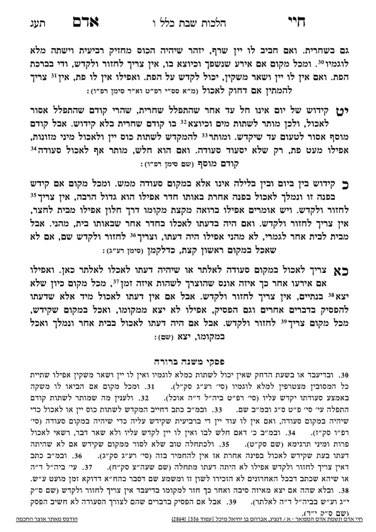We are continuing in siman 20, learning about kiddush b’mokom seudah. We left off discussing a person who makes kiddush in the sukkah and is forced to leave, or vice versa, and whether they need to repeat kiddush when they move to their new place since they did not have a seudah in their first mokom.
When they began in the sukkah, the simplest solution is to eat a kezayis of pas or mezonos while in the sukkah in order to be yotzei kiddush b’mokom seudah. If that is not feasible, they could also drink a revi’is of wine and be yotzei that way.
When they began in the house, it is more complicated, because if they can eat in the sukkah, they should not be eating inside. One may argue that the person should quickly eat a kezayis of pas in the house and then go out to the sukkah. However, it will depend on whether it is muttar to eat outside of the sukkah. Generally, the chiyuv to eat in the sukkah is for pas the size of a b’keiah (2 kezeyisim). If so, the kezayis which he needs to eat in order to be yotzei kiddush b’mokom seudah is not considered an achilas keva (fixed meal) which needs to be eaten outside of the sukkah, but is an achias ara’i and can in eaten in the home before moving to the sukkah.
The problem with this argument is that
- it does not work on the first night, because the Mishnah Berurah brings an opinion that the amount which needs to be eaten in the sukkah is a kezayis, and therefore it is assur to eat even a kezayis outside of the sukkah.
- In addition, since a person is eating this kezayis in order to fulfill kiddush b’mokom seudah, arguably they are making the kezayis into an achilas keva, which cannot be done outside of the sukkah.
- Finally, the Shaar Hatziyun writes that even foods which can normally be eaten outside of the sukkah cannot be eaten outside of a sukkah within the context of a meal. For example, a person can drink water outside of a sukkah. However, if they are in the middle of a meal, and they step out of the sukkah momentarily, they should not drink water outside of the sukkah.
- If it begins to rain after making kiddush, and the seudah is moved inside, if they did not have a “seudah” of mezonos or wine, or a kezayis of bread, before moving inside, kiddush should be repeated inside. One should try to have bread, mezonos or wine before moving inside to avoid the issue.
- If one made kiddush inside, and then realized it stopped raining, they should have a revi’is of wine inside before moving out to the sukkah.



